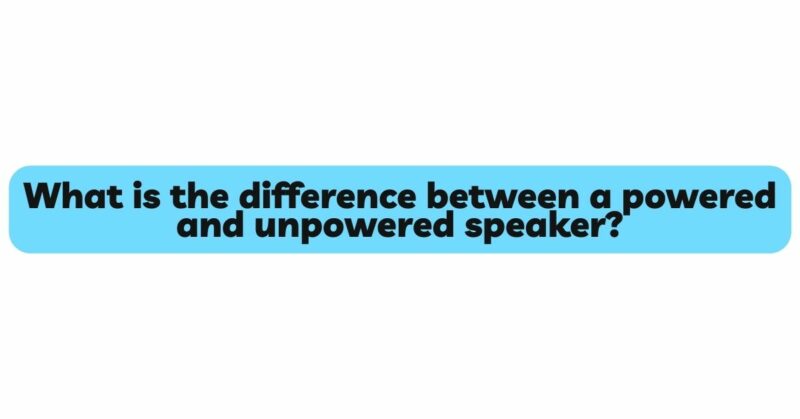In the world of audio technology, the universe of speakers unfolds with an array of options, each catering to distinct audio preferences. Among the most crucial differentiators lie the categories of powered and unpowered speakers. These two variants represent varying approaches to sound reproduction, each with its unique benefits and considerations. In this comprehensive exploration, we dive deep into the realm of speakers, dissecting the differences between powered and unpowered models, uncovering their core characteristics, and highlighting how each contributes to the auditory experience.
Understanding Powered Speakers: Powered speakers, often referred to as active speakers, emerge as self-contained audio solutions that integrate amplification within their enclosures. These speakers possess built-in amplifiers that eliminate the need for external amplification equipment. The audio signal is directly fed into the speaker, where it undergoes amplification before being channeled to the speaker drivers to produce sound waves.
Advantages of Powered Speakers: Powered speakers offer a range of benefits that cater to various audio preferences and setups:
- Simplicity and Convenience: The integration of amplification within the speaker eliminates the need for external amplifiers, simplifying setup and reducing clutter.
- Optimized Match: Powered speakers are designed and optimized to work harmoniously with the built-in amplification, ensuring an efficient and coherent audio performance.
- Plug-and-Play: With no external amplification required, powered speakers are essentially plug-and-play devices, making them accessible to audio enthusiasts of all levels.
- Integrated Signal Processing: Some powered speakers include built-in signal processing features like equalization and digital signal processing (DSP), enabling users to tailor the sound output to their preferences.
Understanding Unpowered Speakers: Unpowered speakers, often known as passive speakers, differ fundamentally in that they lack built-in amplification. These speakers require external amplification to convert electrical audio signals into sound waves. Unpowered speakers consist of components such as speaker drivers, crossovers, and enclosures, which work in conjunction with external amplifiers to create sound.
Advantages of Unpowered Speakers: Unpowered speakers offer their own set of advantages, appealing to audiophiles seeking specific audio qualities and customization:
- Amplifier Flexibility: The absence of built-in amplification provides users the freedom to choose amplifiers that align with their sound preferences, room acoustics, and setup requirements.
- Upgrade Potential: Upgrading amplifiers for unpowered speakers is straightforward and doesn’t necessitate replacing the entire speaker unit, making it easier to adapt to changing audio needs.
- Customized Sound Experience: Users can tailor their sound experience by selecting amplifiers with specific sonic characteristics that complement their music preferences.
- Scalability: Unpowered speakers can be seamlessly integrated into various audio setups, making them versatile for a range of applications.
Comparing Technical Aspects: Beyond the fundamental distinction between amplification integration, powered and unpowered speakers differ in several technical aspects:
- Sound Quality: Powered speakers benefit from optimized integration between amplification and drivers, while unpowered speakers’ sound quality relies on the external amplifier’s quality.
- Complexity: Powered speakers are inherently more complex due to the integration of amplification, while unpowered speakers are simpler in design, comprising speaker drivers, crossovers, and enclosures.
- Cost: Powered speakers generally cost more due to the inclusion of amplification hardware, while unpowered speakers can be more budget-friendly.
- Portability: Powered speakers often have more weight due to integrated amplification, whereas unpowered speakers can be lighter and more portable.
Application Scenarios: Both powered and unpowered speakers find their place in various scenarios:
- Powered Speakers: Powered speakers are ideal for scenarios where simplicity, convenience, and a self-contained audio solution are desired. They are commonly used in computer setups, multimedia systems, and small-scale audio environments.
- Unpowered Speakers: Unpowered speakers shine in scenarios where customization, tailored amplification, and the potential for audio system expansion are priorities. They are often chosen for home audio, home theater, studio monitoring, and live sound setups.
Conclusion: The realm of audio technology is an intricate symphony of choices, each serving a unique purpose in the pursuit of sonic excellence. While powered speakers offer the convenience of integrated amplification and optimized synergy, unpowered speakers provide the freedom to craft a customized sound experience through external amplification. Recognizing the differences between these two categories empowers audiophiles to make informed decisions, allowing them to curate soundscapes that resonate with their distinct preferences and aspirations. Whether it’s the convenience of plug-and-play solutions or the pursuit of tailored audio perfection, the world of powered and unpowered speakers continues to enrich the auditory journey in its multifaceted glory.


